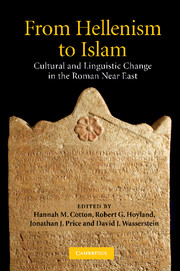Book contents
- Frontmatter
- Contents
- List of figures
- List of tables
- List of contributors
- Preface
- List of abbreviations
- Introduction: documentary evidence, social realities and the history of language
- Part I THE LANGUAGE OF POWER: LATIN IN THE ROMAN NEAR EAST
- Part II SOCIAL AND LEGAL INSTITUTIONS AS REFLECTED IN THE DOCUMENTARY EVIDENCE
- Part III THE EPIGRAPHIC LANGUAGE OF RELIGION
- 7 ‘Languages’ and religion in second- to fourth-century Palestine: in search of the impact of Rome
- 8 The epigraphic habit and the Jewish diasporas of Asia Minor and Syria
- 9 Religion and language in Dura-Europos
- Part IV LINGUISTIC METAMORPHOSES AND CONTINUITY OF CULTURES
- Part V GREEK INTO ARABIC
- Index
8 - The epigraphic habit and the Jewish diasporas of Asia Minor and Syria
Published online by Cambridge University Press: 01 March 2010
- Frontmatter
- Contents
- List of figures
- List of tables
- List of contributors
- Preface
- List of abbreviations
- Introduction: documentary evidence, social realities and the history of language
- Part I THE LANGUAGE OF POWER: LATIN IN THE ROMAN NEAR EAST
- Part II SOCIAL AND LEGAL INSTITUTIONS AS REFLECTED IN THE DOCUMENTARY EVIDENCE
- Part III THE EPIGRAPHIC LANGUAGE OF RELIGION
- 7 ‘Languages’ and religion in second- to fourth-century Palestine: in search of the impact of Rome
- 8 The epigraphic habit and the Jewish diasporas of Asia Minor and Syria
- 9 Religion and language in Dura-Europos
- Part IV LINGUISTIC METAMORPHOSES AND CONTINUITY OF CULTURES
- Part V GREEK INTO ARABIC
- Index
Summary
The Jewish diaspora of Asia Minor, one of the most vital centres of Jewish diaspora life in antiquity, has left us many testimonies of its life: material remains, ranging from synagogue buildings to lamps; written sources, both pagan and Christian; and, of course, inscriptions. The evidence of inscriptions has the distinct advantage of having been written for and by the Jews of Asia Minor themselves: we are looking not through the eyes of foreign observers, but through their own eyes – even if they adapted themselves to their surroundings and joined the world of epigraphy, the world of communication established by the Greek inhabitants of Asia Minor. Even if we know only about 250 Jewish inscriptions, their distribution in time and place corresponds perfectly with that of inscribed texts in general. The Jewish inscriptions can therefore be seen as media of communication both with the outside world and within the community (sections on ‘The epigraphic habit’ and ‘The use of different kinds of inscriptions’); if pagans, Christians and Jews used, in part, the same language and the same means of expression, we shall have to look at the consequences for identity in the Jewish diaspora: to what extent did the Jews accept local identities (section on ‘Local Identities’)? Of course, there were always differences among religious identities, but were these differences strong enough to overcome the similarities which grew out of living together in the cities and in the countryside of Asia Minor, and sharing the same social and local conditions (‘Religious Identities’)?
The ability to use the same words for the diaspora in Asia Minor and in Syria suggests (at first glance) that circumstances were almost identical.
- Type
- Chapter
- Information
- From Hellenism to IslamCultural and Linguistic Change in the Roman Near East, pp. 203 - 234Publisher: Cambridge University PressPrint publication year: 2009
- 1
- Cited by



